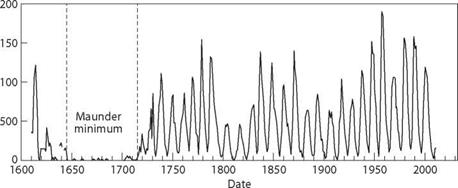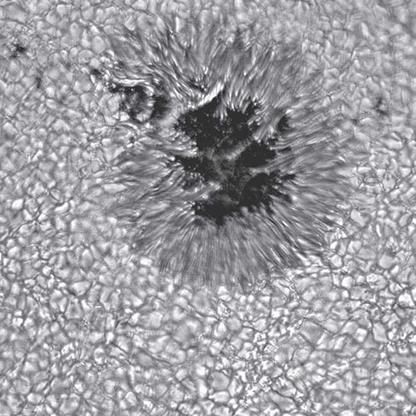Living with a Star
Humans have always been aware that the Sun’s rays sustain life on Earth. But until the invention of the telescope, the Sun was thought to be smooth and pristine. There’s some evidence of naked-eye observations of sunspots in China as early as 28 BC, and possibly several centuries earlier.3 Aristotle’s strong supposition that the heavens were perfect meant that sunspots probably went undiscovered in Europe for nearly two thousand years. Galileo saw sunspots in 1610 and noticed that they rotated with the Sun. Jesuit astronomer Christoph Scheiner also observed them soon after, and he believed them to be orbiting satellites.4 But by 1630, Scheiner had abandoned his Aristotelian view and accepted that sunspots rotated at different rates, faster at the equator and slower at the poles. This proved that the Sun couldn’t be a solid object but was more probably composed of gas or liquid. Through the seventeenth century, the number of sunspots declined almost to zero, giving a first hint of the Sun’s effect on our weather, as a period of low sunspot numbers called the Maunder minimum corresponded to decades when Europe went into a deep freeze, with southern England ice-bound and people in Holland skating on the frozen canals all summer. It wasn’t until the 1840s that Heinrich Schwabe discovered that sunspot numbers varied with an eleven-year cycle (figure 7.1).
|

Around the same time that Galileo was doing his pioneering work with the telescope, William Gilbert recognized that the Earth had a magnetic field similar to the dipole field of magnetized rocks called lodestones. Over the next several hundred years, scientists explored the Earth’s invisible magnetic field and showed that it fluctuated in ways that seemed to depend on the Sun. In 1777, Johann Wilcke noticed that auroral rays in the polar regions lay along the field lines of Gilbert’s dipole. Then, in 1859, two scientists observed a white light flare on the Sun, followed two days later by a geomagnetic storm on the Earth.5 This once-in-a-millennium event caused aurorae all around the world, including places that had never experienced such a phenomenon in human memory, such as the Caribbean. The northern lights were so bright in the North American Rockies that miners ate breakfast, convinced that the day had started. Telegraph systems failed worldwide and operators reported that they received severe shocks by sparks leaping from the equipment.
Coincidences like this were provocative, but they didn’t amount to an explanation. In 1896, Norwegian scientist Kristian Birkeland devised an elegant experiment where the Sun was represented by a cathode and the Earth by a spherical, magnetized anode. With both situated in a large vacuum chamber, he watched as the appa
ratus behaved like a miniature Earth-Sun system, with an electrical discharge like an aurora occurring at high geomagnetic latitudes. Not long afterward, George Ellery Hale built the first instrument to study solar flares in detail, on Mount Wilson in California, and he confirmed the two-day lag between flares and geomagnetic storms on Earth. Hale proved that sunspots were magnetized—the first detection of magnetic fields beyond the Earth. He also showed that the polarity of sunspot pairs is the same within a cycle, but reverses from one sunspot cycle to the next.6
Many researchers have looked for correlations between sunspots and weather on the Earth. Sunspots are actually cooler than the area around them, because the tight bundle of magnetic field lines that they contain restricts the convection that carries heat up from the solar interior. How, therefore, could a sunspot minimum correspond to colder temperatures on the Earth? In part it’s because the area around a sunspot is brighter than an average patch of the Sun’s surface (figure 7.2). So the Sun is brighter when there are more sunspots. But that still leaves a mystery. When scientists developed digital detectors in the 1970s, they found that the full variation of the Sun’s brightness over a sunspot cycle was only one part in a thousand, or 0.1 percent, not nearly big enough to explain significant temperature variations on Earth. The Maunder Minimum aside, there’s no convincing evidence that the sunspot cycle drives non-s easonal climate change, especially the rise in global temperatures over the past half century.7
However, the variations of the Sun in invisible forms of high – energy radiation are much more extreme than its variation in visible light. Moreover, space isn’t the simple and absolute vacuum that most scientists once imagined. Fifty years ago it was shown that the Sun is surrounded by a vast region of plasma, a diffuse, magnetized gas so hot that the particles are traveling near light speed. The stream of particles emerging from the Sun—the solar wind—travels millions of miles to us, where it hits and distorts the Earth’s magnetic field.8 Even though the nature of the effects is complex and subtle, the Sun and Earth are one connected system.
|
Figure 7.2. The cells and granulation seen in this image of the surface of the Sun reflect seething, turbulent motions of high temperature plasma. Sunspots occur in pairs and are slightly cooler areas where the photosphere is threaded by an organized magnetic field and high-energy particles and energy can escape. This one is about the size of the Earth (NASA/SOHO). |











